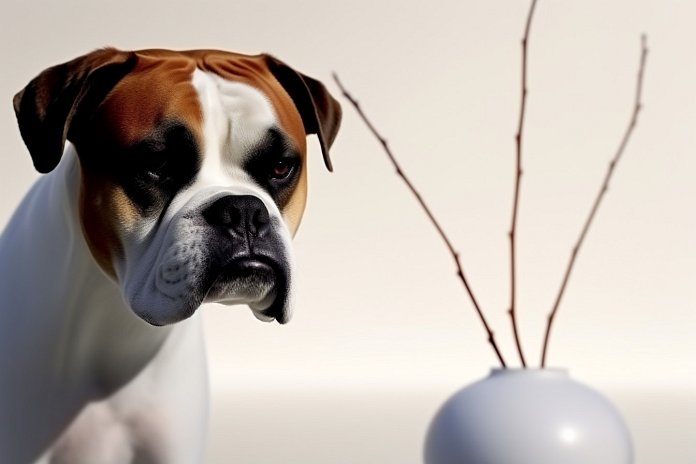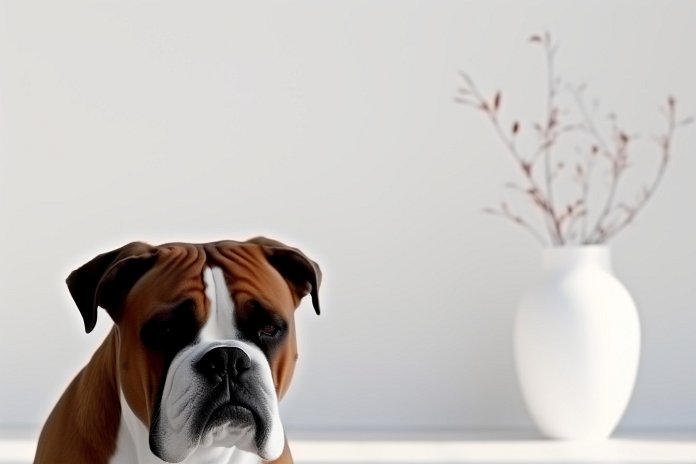
The traits of your dog can be understood by studying the characteristics of its two parent breeds. A mixed-breed dog, like the Boxita, is a result of crossing two distinct breeds. The Boxita is likely to exhibit qualities of both the Akita and the Boxer. The Akita is known for being a strong and hardworking dog, while the Boxer is an athletic and medium to large-sized breed.
With a short and weather-resistant coat that is often brown and white, the Boxita has a powerful and muscular build. This energetic dog is not only great for work but also loves to play. As a loyal and protective companion, the Boxita would make a wonderful addition to your household. It possesses qualities such as devotion, boldness, and endearment, making it an excellent choice for families.
Ahead, we look at Boxita dog breed, its history, personality, pros and cons of owning an Boxita, characteristics, and must-know facts. We will also examine how to care for this breed and more. Prepare for a tail-wagging adventure into the world of Boxitas!
| Dog Breed | Boxita |
| Size | Large |
| Weight | 65-95 lbs (average) |
| Height | 23-25″ (average) |
| Location | United States |
| Ancestry | Akita, Boxer |
| Date of Origin | Unknown |
| Group | Companion, Guard Dog |
| Life Expectancy | 10-14 years |
| Price | $600 – $1200 |
| Family | Canidae |
| Scientific Name | Canis Lupus Familiaris |
📖 Breed History
The Boxita is a relatively new hybrid breed, so its history is limited. To understand its origins, we look at the histories of its parent breeds. The Akita, recognized by the American Kennel Club (AKC) in 1972, is the 46th most popular breed in the United States. Originating in Japan in the 1600s, Akitas were primarily bred for hunting and some were used for fighting. They were skilled in hunting large animals like bear, deer, and wild boar. In 1927, as dog-fighting lost popularity, the Hozankai Society of Japan was established to preserve the Akita. By 1931, the breed was considered one of Japan’s natural treasures. The loyalty of an Akita named Hachiko, who waited at the train station for his deceased owner every day for almost 10 years, further increased the breed’s popularity. The first Akita in the United States was a gift to Helen Keller from the Japanese government.
The Boxer, on the other hand, was recognized in 1904 and currently ranks as the 10th most popular dog breed in the United States. It is believed that the Boxer originated either from the Tibetan fighting dogs or from Germany in the 1800s, where it was used as a livestock dog and for bull-baiting. The breed was developed by crossing two mastiff-type dogs, which, like the Akita, were also used in hunting large animals such as bear and wild boar. It is thought that the Boxer was later crossed with the Bulldog in the 19th century to create the modern breed we know today, which has gained popularity worldwide.

🐕 Boxita Appearance
Looking at the parent breeds, the Akita and the Boxer, is the greatest method to predict how your Boxita will look. Both of them are enormous canines, standing over 24 inches height and weighing, on average, 90 to 120 pounds. The Boxita looks more like the Akita than the Boxer, with a square head, a medium-sized nose, and triangular ears that are floppy. Typically, they have two colors that are either brown and white, yellow and white, sable and white, black and white, or golden and white. They are content to be outside in the sun or the snow thanks to their short, weather-resistant fur.
| 👀 Eye Color | Varies |
| 🐽 Nose Color | N/A |
| 🐕 Coat Color | Ranges |
⚡ Fun Fact: Boxita dogs are a social breed. They enjoy being around people or other animals. This breed doesn’t tolerate being left alone.
🐶 Traits & Temperament of Boxita
Despite being developed as fighting breeds, the Akita and the Boxer no longer exhibit aggressive traits because to careful breeding. The Boxita is a wonderful family companion because of its gentle nature, enthusiasm, and affection for kids and other animals. Sometimes they are jokesters who will bring you their empty bowl of food, and other times they will protect you and your family from outsiders. Although they are reasonably simple to train, success depends on consistency in your efforts. Like other dogs, the Boxita responds best to positive reinforcement because harsh punishment might make your dog hostile.
🤝 Are Boxitas Friendly or Aggressive?
Boxita dogs are known to get along well with other pets and are generally friendly towards strangers. They are also considered kid-friendly dogs, making them a great choice for families with children. Additionally, Boxita dogs tend to have an average level of friendliness towards cats and other dogs. Due to their calm and gentle nature, they are often recommended as suitable companions for elderly individuals.
This breed is known for being:
- Playful
- Dignified
- Independent
- Energetic
- Protective
- Alert
- Courageous
- Intelligent
- Confident
- Friendly
- Responsive
- Docile
- Loyal
- Fearless
- Faithful
- Brave
- Bright
- Vigilant
- Willing
🐩 Boxita Care & Maintenance
The Boxita requires little upkeep to keep them looking smart and alluring because of their short, silky coat. The skin will remain healthy and shedding will be kept to a minimal if you brush them once or twice a week using a hard bristle brush. When necessary, you may give them a gentle dog shampoo bath, but avoid doing so too frequently as this can remove the protective oils that their skin needs to keep healthy. Once a week, check your dog’s ears for wax, dirt, and debris accumulation and clean them as necessary with a cotton ball or soft cloth. To prevent injuries and rips, trim your pet’s nails as needed. You should also brush your pet’s teeth around twice a week.
Boxita dogs have a higher than average tendency to shed their hair. This is a normal part of their hair growth cycle. The amount and frequency of hair loss can vary depending on the dog’s overall health and the specific breed they belong to. If you’re not a fan of constantly vacuuming up dog hair, you might want to think twice about getting a Boxita puppy. As for bath time, it is recommended to give them a bath every 3-4 weeks to keep them clean and healthy.
🍖 Food: We recommend few cups daily, costing you about $0.49 – $1.49 daily, or roughly $30.00 a month.
🐾 Exercise: Boxita dogs need quite a lot of exercise. Daily walks should be on schedule. If you live an active life, this breed can be a good choice for you.
This dog breed requires to be walked for roughly few miles per week, which equates to about 15 – 35 minutes of physical activity daily. This consistent moderate exercise regimen will help maintain their physical wellness and significantly contribute to their mental stimulation. Consciously setting aside this time for your furry friend can dramatically enhance their life quality, helping them stay energetic, healthy, and mentally alert.
Did you know: Boxita dogs are high-energy dogs. An active lifestyle makes them happy.
❤️🩹 Boxita Health & Issues
Some of the major concerns for Boxita Dog Breed can be:
- Entropion
- Ectropion
- Cardiomyopathy
- Hip Dysplasia
- Subvalvular Aortic Stenosis
- Degenerative Myelopathy
- Corneal Dystrophy
While minor concerns include:
- Progressive Retinal Atrophy
- Cataracts
- Atopic Dermatitis
🤧 Important: Is Boxita hypoallergenic? No.
✨ Bonus: Check out cool, creative, and funny names for Boxita.
⚡ Boxita Dog Breed Facts
What makes the Boxita a great choice for families with young children?
The Boxita is a great choice for families with young children because they are known to be loving, loyal, and gentle with kids. They have a sweet disposition and are typically patient and tolerant, making them a suitable companion for children.
Is the Boxita breed considered a suitable breed for apartment living?
The Boxita breed is not considered suitable for apartment living due to their energetic and active nature. They require ample space to exercise and play, so a house with a yard would be more suitable for them.
How much exercise does a Boxita require compared to other breeds?
A Boxita requires a moderate amount of exercise compared to some other breeds. They are energetic dogs that enjoy physical activity, so daily walks and playtime are essential to keep them mentally and physically stimulated.
Is the Boxita breed known for being good with other pets?
Boxitas are generally good with other pets, including dogs and cats, especially if they are properly socialized from a young age. However, it is always important to supervise interactions between pets and introduce them slowly to ensure compatibility.
What are other low-maintenance dog breeds similar to the Boxita?
Some low-maintenance dog breeds similar to the Boxita include the Labrador Retriever, Beagle, and Vizsla. These breeds require minimal grooming and are generally easy-going in nature.
What are the common health issues that Boxitas are prone to?
Boxitas are prone to certain health issues, including hip dysplasia, hypothyroidism, allergies, and heart conditions. Regular vet check-ups and a balanced diet can help prevent or manage these health concerns.
Are Boxitas known to be easy to train compared to other breeds?
Boxitas are known to be moderately easy to train. They are intelligent and eager to please, but consistency and positive reinforcement methods are key to successful training.
Are Boxitas more prone to separation anxiety compared to other breeds?
Boxitas can be prone to separation anxiety if not properly trained and socialized. They thrive on human companionship and may become anxious or destructive when left alone for long periods. Early training and gradual alone-time exposure can help prevent separation anxiety.
Are there any dog breeds similar to the Boxita that are suitable for people with allergies?
Some dog breeds similar to the Boxita that are suitable for people with allergies include the Poodle, Bichon Frise, and Portuguese Water Dog. These breeds have hypoallergenic coats and produce fewer allergens.
What sizes of dogs similar to the Boxita are best for individuals or families with limited space?
Small to medium-sized dogs similar to the Boxita, such as the Cocker Spaniel, Bulldog, and French Bulldog, are best for individuals or families with limited space. These breeds can adapt well to apartment living with regular exercise.
Is the Boxita breed known to be good with children with special needs?
The Boxita breed is generally good with children, including those with special needs. However, as with any dog, supervision and proper training and socialization are essential to ensure a safe and harmonious relationship between the dog and the child.
How does the grooming and shedding needs of the Boxita?
The grooming needs of the Boxita are moderate. They have a short, weather-resistant coat that requires regular brushing to keep it clean and healthy. They are moderate shedders, so regular grooming and occasional baths are necessary to maintain their coat’s condition.
We use reliable and publicly available data and resources such as AKC and American Canine Registry to ensure that Boxita dog breed information is accurate and up to date. If you spot an error, please don’t hesitate to bring it to our attention.